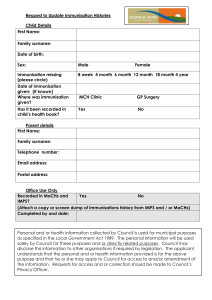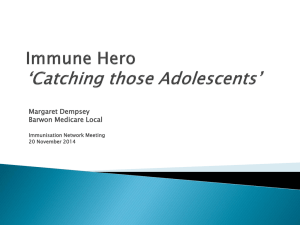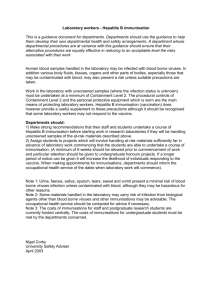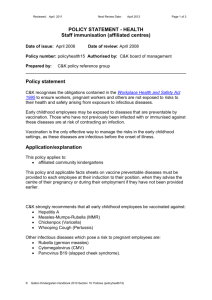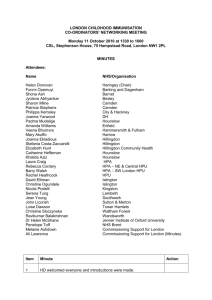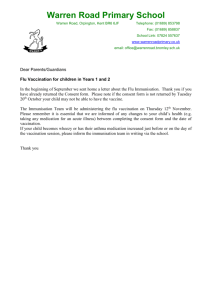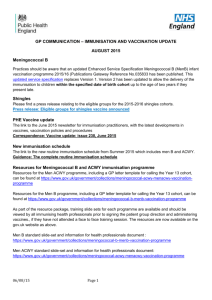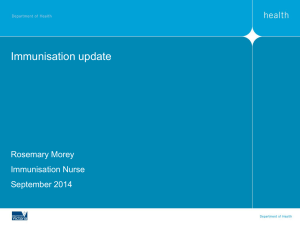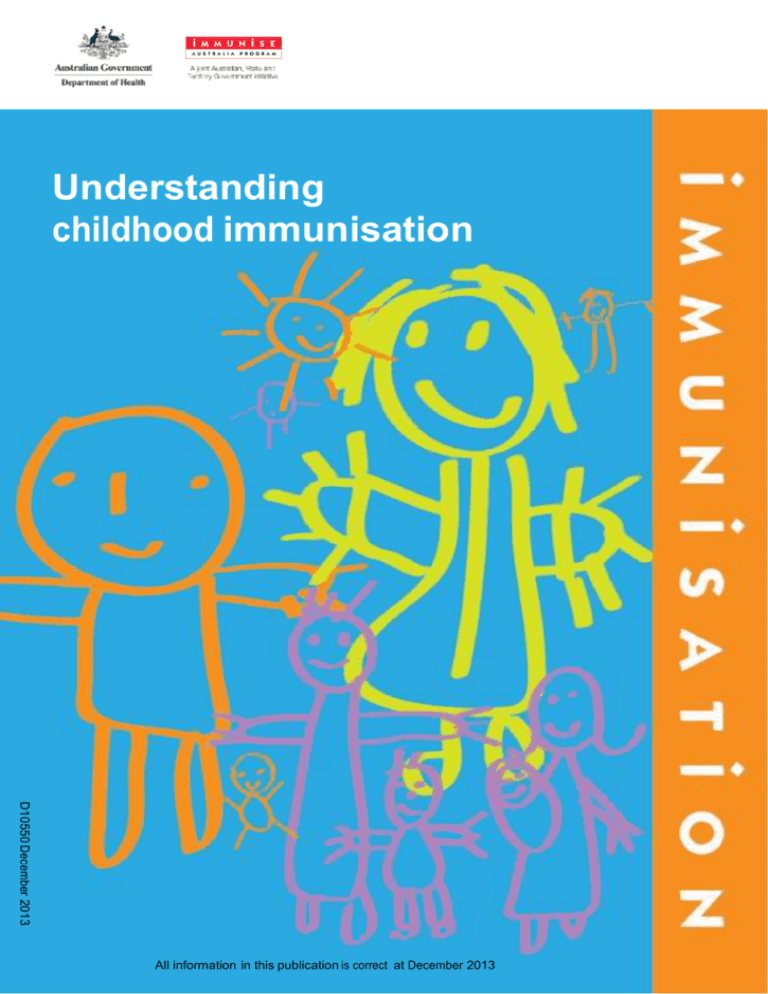
Understanding
childhood immunisation
D10550 December 2013
All information in this publication is correct at December 2013
Understanding
childhood immunisation
Understanding Childhood Immunisation
ISBN: 978-1-74186-078-8
Publications approval number: 10550
© Commonwealth of Australia 2013
This work is copyright. You may download, display, print and
reproduce the whole or part of this work in unaltered form for
your own personal use or, if you are part of an organisation, for
internal use within your organisation, but only if you or your
organisation do not use the reproduction for any commercial
purpose and retain this copyright notice and all disclaimer
notices as part of that reproduction. Apart from rights to use
as permitted by the Copyright Act 1968 or allowed by this
copyright notice, all other rights are reserved and you are not
allowed to reproduce the whole or any part of this work in
any way (electronic or otherwise) without first being given the
specific written permission from the Commonwealth to do
so. Requests and inquiries concerning reproduction and rights
are to be sent to the Communication Branch, Department of
Health, GPO Box 9848, Canberra ACT 2601, or via e-mail to
copyright@health.gov.au.
Contents
Section 1
What is immunisation? ......................................................................... 5
Section 2
Immunisation: the basics ...................................................................... 7
Section 3
The vaccines and the diseases they prevent ........................................ 9
Starting at birth
Hepatitis B ............................................................................................................ 9
Starting at 2 months
Diphtheria, tetanus and whooping cough (Pertussis) ............................................. 9
Haemophilus influenza type b (Hib)..................................................................... 10
Poliomyelitis (Polio) ............................................................................................. 10
Pneumococcal..................................................................................................... 11
Rotavirus............................................................................................................. 12
Starting at 12 months
Meningococcal C ................................................................................................ 12
Measles, mumps and rubella............................................................................... 13
Starting at 18 months
Varicella (chicken pox)......................................................................................... 13
In early childhood
Influenza............................................................................................................. 14
Section 4
Special immunisation requirements for Aboriginal
and Torres Strait Islander children ......................................................15
Section 5
Common questions for children who
are medically at risk. ............................................................................16
Section 6
Common questions on getting immunised ........................................17
Section 7
Common questions on immunity and immunisation.........................20
Section 8
Pain relief for children to reduce side effects ................................... 22
Section 9
Immunisation and your eligibility for some
Government benefits .......................................................................... 23
Section 10
Glossary................................................................................................ 25
Section 11
Enquiries. ............................................................................................. 26
3
Understanding childhood immunisation
Immunisation is a simple, safe and effective way of
protecting children against certain diseases. The risks
of these diseases are far greater than the very small
risks of immunisation.
Immunisation is still the safest and most effective way
to prevent disease worldwide. In fact, it’s estimated that
vaccination currently saves approximately three million
lives each year.
Parents understandably want to do whatever they can
to stop their child getting sick. This booklet will help you
make an informed decision on immunisation based on
the best available information.
If you have any questions about the information in this
booklet, please discuss with your General Practitioner
or immunisation provider.
4
Understanding childhood immunisation
Section 1
What is
immunisation?
Immunisation protects people against
harmful infections before they come into
contact with them in the community.
Immunisation uses the body’s natural
defence mechanism — the immune response
— to build resistance to specific infections
and helps children (and adults) stay healthy
by preventing serious infections. It copies
the body’s protective response to diseases,
helping the immune system detect and
destroy the infection when it is encountered
in the future — before significant symptoms
or complications can occur.
5
Understanding childhood immunisation
This booklet focuses on the vaccines for young children
funded under the National Immunisation Program.
The routine childhood immunisations given through this
program currently provide protection against
13 diseases:
•
•
•
•
•
•
•
•
•
•
•
•
•
diphtheria;
haemophilus influenzae type b (Hib);
hepatitis B;
measles;
meningococcal C;
mumps;
whooping cough (pertussis);
pneumococcal;
polio (poliomyelitis);
rotavirus;
rubella (German measles);
tetanus; and
chickenpox (varicella).
Section 1: What is immunisation?
Most of these diseases can cause serious complications
and sometimes death. Most vaccines used in the
program are given by injection; the rotavirus vaccine is
given orally (by mouth).
It is also recommended that children at risk receive the
seasonal influenza vaccination.
Why should I have my child immunised?
There are two main reasons for immunising every child in
Australia:
1.
Immunisation is the safest and most effective
way of giving protection against a disease. After
immunisation, your child is far less likely to catch
the disease if there are cases in the community.
The benefit of protection against the disease far
outweighs the very small risks of the side effects
associated with immunisation.
2.
If enough people in the community are
immunised, the infection can no longer be
spread from person to person and the disease
might die out altogether. This is how smallpox
was eliminated from the world, and how polio
has disappeared from many countries. This is
known as ‘herd immunity’.
Immunisation and vaccination — what’s the
difference?
Technically, ‘vaccination’ is the term used for giving a
vaccine — that is, actually getting an injection or oral
dose. ‘Immunisation’ is the term used for the process of
both getting the vaccine and becoming immune to the
disease as a result of the vaccine. Most people use the
terms ‘vaccination’ and ‘immunisation’ interchangeably
but their meanings are not exactly the same because
immunity follows vaccination in most, but not all, cases.
For the purposes of this booklet, we have always used
the term ‘immunisation’ because this is the expression
most commonly used in the community.
Fact
All vaccines available in Australia have
been thoroughly tested for safety and
efficacy and receive ongoing monitoring
and evaluation.
6
Understanding childhood immunisation
Section 2
Immunisation:
The Basics
What is in vaccines?
Depending on their purpose and specific composition,
vaccines can contain a very small dose of a live, but
weakened virus, killed viruses, killed bacteria or small
parts of bacteria, or a small dose of a modified toxin
produced by bacteria. Vaccines may also contain either
a small amount of preservative or a small amount of an
antibiotic to preserve the vaccine. Some vaccines may
also contain a small amount of an aluminum salt which
helps produce a better immune response.
Some vaccines, such as influenza, may contain traces of
egg protein and should be given with caution to people
with a known egg allergy.
What are the side effects of immunisation?
Common side effects of immunisation are redness and
soreness where the child has been injected, and mild
fever. While these symptoms may concern you and upset
your child at the time, the benefit of immunisation is
protection from the disease. More serious reactions to
immunisation are very rare. You may consider using pain
relief to help ease the fever and soreness. Other side
7
Understanding childhood immunisation
effects are very rare but if they do occur, consult
a doctor immediately. Side effects of specific vaccines
are described in Section 3 - The vaccines and the
diseases they prevent (page 9).
How long do immunisations take to work?
In general, the normal immune response takes
approximately two weeks. This means protection from
an infection will not occur immediately after the vaccine
is received.
Most immunisations need to be given more than
once to build long lasting protection. For example,
a child who has been given only one or two doses of
diphtheria-tetanus-acellular pertussis vaccine (DTPa) is
only partially protected against diphtheria, tetanus and
pertussis (whooping cough), and may still become sick
if exposed to these diseases. However, some vaccines
provide long lasting immunity after only one dose.
Section 2: Immunisation: The Basics
How long do immunisations last?
The protective effect of immunisation is not always lifelong. Some, like tetanus vaccine, can last up to 30 years,
after which time a booster dose may be given. Some,
such as whooping cough, give protection for about five
years after a full course.
Seasonal influenza vaccinations need to be given
every year.
Is everyone protected from disease by
immunisation?
Even when all the doses of a vaccine have been given,
not everyone is protected against the disease. For
example, measles, mumps, rubella, tetanus, polio and
hib vaccines protect more than 95 per cent of children
who have completed the course.
Three doses of whooping cough (pertussis) vaccine
protects about 85 per cent of children who have been
immunised, and will reduce the severity of the disease in
the other 15 per cent, if they do catch whooping cough.
Booster doses are needed because immunity decreases
over time. However, the more people vaccinated against
a particular disease the less likely it is that the disease
can be transmitted in the community.
Are all immunisations free?
Vaccines that are routinely recommended for your child
under the National Immunisation Program are funded
by the Australian Government and are provided free of
charge if your child is eligible for Medicare. Your doctor
may charge you for a consultation fee. These vaccines
protect against a number of diseases including:
•
•
•
•
•
•
•
•
8
hepatitis B;
diphtheria, tetanus and whooping cough;
haemophilus influenzae type b;
meningococcal C;
polio;
pneumococcal;
rotavirus; and
measles, mumps, rubella and chickenpox (varicella).
Understanding childhood immunisation
Some additional vaccines are also provided free of
charge for:
• Children with specific medical conditions (see page 16) ;
and
• Aboriginal and Torres Strait Islander children in the
Northern Territory, Western Australia, South Australia
and Queensland. See Section 4, page 15, for more
details.
It is important that your child receives all vaccines when
they are due to ensure they have the best protection
possible. In addition, some vaccines such as rotavirus can
only be given within specific age limits.
There are some differences in the way governmentfunded immunisation programs are administered in each
state and territory. Speak to your General Practitioner or
immunisation provider about what your child can receive
under these programs. Alternatively, contact your state
or territory health department. Contact numbers can be
found at the end of this booklet.
There are other vaccines available that are not funded
by the National Immunisation Program. These are
usually recommended in special circumstances, such
as international travel or for people engaged in certain
occupations. If you choose to immunise your child with
a vaccine that is not funded by the Program, you should
speak to your local GP or immunisation provider for
further information.
If you are unsure which vaccines are free, refer
to the National Immunisation Program Schedule
available at immunise.health.gov.au, check with
your doctor, immunisation clinic, or telephone
the Immunise Australia Information Line on
1800 671 811.
Section 3
The vaccines
and the diseases
they prevent
Vaccines are listed by the age of the child
at which they are first administered. Most
post-vaccine discomfort or side effects can
be readily managed with pain relief.
Side effects of immunisation:
About one in 15 has pain at the site of injection and
one in 100 people experiences fever. Anaphylaxis
(a sudden and severe allergic reaction which results
in a serious fall in blood pressure) occurs in about
one in 600,000.
At birth
Hepatitis B
For more information on hepatitis B immunisation visit
the Immunise Australia website immunise.health.gov.au
Disease: Hepatitis B
Contagious virus spread mainly by blood, sexual
contact or from mother to newborn baby.
Causes acute hepatitis or chronic carriage.
Starting at 2 months
Effects of the disease:
Diphtheria, tetanus and whooping cough
(pertussis)
About one in four chronic carriers will develop cirrhosis
or liver cancer.
Disease: Diphtheria
How to immunise and when:
Contagious bacteria spread by droplets; causes severe
breathing difficulties.
Several doses of hepatitis B vaccine are required to
provide full protection against the disease. For babies,
the first dose is given soon after birth, the second is
due at 2 months of age (but can be given as early as
6 weeks of age), the third at 4 months of age and
the final at 6 months of age. The last three doses
are combined with other vaccines, such as DTPa
(diphtheria-tetanus-acellular pertussis).
9
Understanding childhood immunisation
Effects of the disease:
About one in 15 patients dies. The bacterium releases
a toxin, which can produce nerve paralysis and heart
failure.
No vaccinated person has died from diphtheria in
Australia in the last 20 years.
Section 3: The vaccines and the diseases they prevent
Disease: Tetanus
Haemophilus influenza type b
Caused by toxin of bacteria from soil. Causes painful
muscle spasms, convulsions and lockjaw.
Disease: Haemophilus influenzae type b (Hib)
Effects of the disease:
Contagious bacteria spread by droplets; causes
meningitis, epiglottitis (respiratory obstruction),
septicaemia, osteomyelitis (infection of the bones).
About three in 100 patients die. The risk is greatest for
the very young or old.
Disease: Whooping cough
Contagious bacteria spread by droplets. Causes
uncontrolled coughing and vomiting lasting up to
three months.
Effects of the disease:
About one in 200 whooping cough patients under
the age of 6 months dies from pneumonia or brain
damage.
How to immunise and when:
Immunisation with a DTPa-containing (diphtheria,
tetanus and whooping cough) vaccine is the best way
to prevent diphtheria, tetanus and whooping cough.
DTPa-containing vaccine is given at 2, 4 and 6 months
of age (but can be given from 6 weeks) with a booster
dose at four years of age, that can be given from
3 years 6 months of age.
Effects of the disease:
About one in 20 meningitis patients dies and one in
four survivors has permanent brain or nerve damage.
About one in 100 epiglottitis patients die.
How to immunise and when:
Several doses of Hib vaccine are required to protect
a child against Hib disease. Doses are given at 2, 4, 6
and 12 months of age. The early doses are given in a
combination vaccine with DTPa, polio and hep B.
Side effects of immunisation:
About one in 20 has discomfort or local inflammation.
About one in 50 has a fever.
For more information on Haemophilus influenzae
type b (Hib) visit the Immunise Australia website
immunise.health.gov.au
As the protective effect of the childhood vaccine can
wear off, a booster dose of diphtheria-tetanusacellular pertussis vaccine is also given to teenagers.
Poliomyelitis (Polio)
Side effects of immunisation:
Contagious virus spread by faeces and saliva; causes
fever, headache, vomiting and may progress to
paralysis.
About one in 10 has local inflammation at the site of
injection or fever. Serious adverse events are very rare.
For more information on diphtheria, tetanus and
whooping cough (pertussis) and DTPa immunisation
visit the Immunise Australia website
immunise.health.gov.au
Disease: Poliomyelitis (Polio)
Effects of the disease:
About one in 20 hospitalised patients dies and one in
two patients who survive is permanently paralysed.
How to immunise and when:
In the past, oral poliovaccine (OPV) was used routinely
in the immunisation schedule. Since 2005, OPV has
been replaced by inactivated poliomyelitis vaccine (IPV)
which is given by injection. Three doses are required at
2, 4 and 6 months of age. The two month vaccine can
be given from 6 weeks of age.
1
0
Understanding childhood immunisation
Section 3: The vaccines and the diseases they prevent
IPV is given as part of a combined vaccine with DTPa,
hep B and Hib (for babies). IPV is combined with DTPa
and due at 4 years of age but can be given from
3 years 6 months.
It is recommended that the pneumococcal vaccine be
given at the same time as other scheduled vaccines
(see Can more than one immunisation be given at the
same time? Section 6, page 18).
Side effects of immunisation:
Aboriginal and Torres Strait Islander children living in
Queensland, the Northern Territory, Western Australia
and South Australia are eligible for an additional
booster at 12-18 months of age. Children with certain
medical conditions are also considered to be at high
risk and may need a booster, usually around age 4-5.
You should discuss this with your immunisation
provider if you think your child is in a specific high
risk group.
About one in three experiences local redness; one in
seven has pain; one in 10 has fever, decreased appetite
and may cry excessively.
For more information on polio immunisation visit the
Immunise Australia website immunise.health.gov.au
Pneumococcal
Disease: Pneumococcal
Bacteria spread by droplets; causes fever, pneumonia,
septicaemia and meningitis.
Medical conditions that predispose children to
high incidence or high severity of pneumococcal
infection are:
• congenital immune deficiency;
• poor functioning spleen due to conditions such as
sickle cell anemia or surgical removal of the spleen;
Effects of the disease:
• HIV infection, before and after development of AIDS;
About one in 10 meningitis patients dies.
• kidney failure, or relapsing or persistent nephrotic
syndrome;
How to immunise and when:
• Down syndrome;
There are two types of pneumococcal vaccine –
the conjugate vaccine and the polysaccharide vaccine.
The conjugate vaccine works well in babies and young
children and covers the 13 types of pneumococcal
bacteria that most commonly cause disease in children.
The polysaccharide vaccine covers 23 different types
of pneumococcal bacteria but it does not work well
in young children. It is mainly used for vaccination of
adults and is also given as a booster vaccination after
a course of conjugate vaccine for older children with
specific medical conditions who require additional
protection.
• heart disease associated with cyanosis or cardiac
failure;
The type of vaccine and the number of doses required
to provide adequate protection varies depending on the
age of the child when the course of pneumococcal
vaccination is started and whether the child has a
medical condition that puts them at a higher risk.
For babies, the first dose of pneumococcal conjugate
vaccine is recommended at 2 months of age but can
be given from 6 weeks of age, with subsequent doses
at 4 and 6 months of age. Aboriginal and Torres Strait
Islander children and children with specific medical
conditions may need further doses.
Side effects of immunisation:
1
1
Understanding childhood immunisation
• cystic fibrosis;
• insulin-dependent diabetes mellitus;
• cerebrospinal fluid leak;
• intracranial shunts and cochlear implants;
• immunosuppressive therapy (such as cancer
treatment or large doses of steroids);
• all premature infants with chronic lung disease; and
• all infants born at less than 28 weeks gestation.
Polysaccharide vaccine: one in two has pain or local
reaction at the site of injection. Conjugate vaccine:
About one in 10 has a local reaction at the site of
injection or fever.
For more information on pneumococcal
immunisation visit the Immunise Australia website
immunise.health.gov.au
Section 3: The vaccines and the diseases they prevent
Rotavirus
Disease: Rotavirus
Contagious virus spread by faeces and saliva; causes
severe gastroenteritis and fever.
Effects of the disease:
About eight in 100 are taken to an emergency
department; four in 100 are hospitalised.
Starting at 12 months
Meningococcal disease
Disease: Meningococcal C
Bacteria spread by respiratory droplets; causes
sepsis (infection of the blood stream) and meningitis
(infection of the tissues surrounding the brain).
How to immunise and when:
Effects of the disease:
Rotavirus vaccine is the best way to protect children
against rotavirus disease. The vaccine will not prevent
diarrhoea and vomiting caused by other infectious
agents.
About one in 10 patients dies. Of those that survive,
one in 30 has severe skin scarring or loss of limbs, and
one in 30 has severe brain damage.
Rotavirus vaccine is given in two or three doses,
depending on the vaccine brand used. The vaccine is
given orally, at the same time as other vaccines at 2, 4
and 6* months of age.
The combination meningococcal C and haemophilus
influenzae type b vaccine is given at 12 months of age.
This vaccine can be given at the same time as other
vaccines that are due at 12 months of age.
*depending on the brand used.
Side effects of immunisation:
There is an upper age limit for the administration of
rotavirus vaccine.
About one in 10 has local inflammation at the site of
injection, fever, irritability, temporary loss of appetite or
headaches.
It is very important to give each dose on time, as
late doses cannot be given. The safety of the vaccine
has not been tested in older babies or children. It is
important, therefore, to ensure that your child receives
this vaccine as close to the recommended age as
possible.
Side effects of immunisation:
Up to three in 100 develop diarrhoea or vomiting.
There is a slightly increased risk of intussusception,
a rare form of bowel blockage, associated with the
rotavirus vaccine. However, the risks of rotavirus
are many times greater than the very small risk of
immunisation.
For more information on rotavirus and rotavirus
immunisation visit the Immunise Australia website
immunise.health.gov.au
1
2
Understanding childhood immunisation
How to immunise and when:
For more information on Meningococcal disease
(Hib-MenC) visit the Immunise Australia website
immunise.health.gov.au
Section 3: The vaccines and the diseases they prevent
Measles, mumps and rubella
Disease: Measles
Highly infectious virus spread by droplets; causes fever,
cough and rash.
Effects of the disease:
One in 15 children with measles develops pneumonia
and one in 1,000 develops encephalitis (brain
inflammation).
For every 10 children who develop encephalitis,
one dies and up to four have permanent brain
damage. About one in 100,000 develops brain
degeneration, which is always fatal.
Side effects of immunisation:
Reactions to MMR immunisation are much less
frequent than the complications of natural measles.
The most common reaction is feeling unwell and
having a low grade fever, possibly with a rash,
occurring 7-10 days after immunisation and lasting
approximately two to three days.
More serious reactions are rare. Thrombocytopenia
(bleeding or bruising) is very rarely associated with the
measles, mumps, rubella vaccine, occurring in three to
five per 100 000 doses of vaccine administered.
For more information on measles, mumps and
rubella immunisation visit the Immunise Australia
website immunise.health.gov.au
Disease: Mumps
Contagious virus spread by saliva; causes swollen neck
glands, fever.
Starting at 18 months
Effects of the disease:
One in 200 children develops encephalitis (brain
inflammation). One in five males past puberty develops
inflammation of the testicles. Occasionally mumps
causes infertility or deafness.
Disease: Rubella
Contagious virus spread by droplets; causes rash, fever
and swollen glands and may cause severe
malformations to babies of infected pregnant women.
Effects of the disease:
About five in 10 patients develop a rash and painful
swollen glands; five in 10 adolescents and adults have
painful joints; one in 3,000 develops thrombocytopenia
(bruising or bleeding); one in 6,000 develops
inflammation of the brain; nine in 10 babies infected
during the first 10 weeks after conception will have a
major congenital abnormality (such as deafness,
blindness, brain damage or heart defects).
How to immunise and when:
The combination measles, mumps and rubella (MMR)
vaccine provides protection against all three diseases
and is given at 12 months of age.
1
3
Understanding childhood immunisation
Varicella (chickenpox)
Disease: Varicella (chickenpox)
Caused by highly contagious virus; causes low grade
fever and vesicular rash
Effects of the disease:
One in 100,000 patients develops encephalitis (brain
inflammation). About three in 100,000 patients die.
Infection during pregnancy can result in congenital
malformations in the baby. Onset of chickenpox
infection in the mother in the period five days before
to two days after delivery results in severe infection in
the newborn baby in up to one-third of cases.
How to immunise and when:
The combination measles, mumps, rubella and varicella
(MMRV) vaccine is given at 18 months of age. This
vaccine replaced the second dose of measles, mumps,
rubella (MMR) vaccine previously given at 4 years of
age and the varicella vaccine at 18 months of age.
Section 3: The vaccines and the diseases they prevent
Side effects of immunisation:
One in 100 recipients may develop swelling of the
salivary glands. One in three million recipients develops
mild encephalitis (inflammation of the brain).
• renal disease;
• haematological disorders; and
• long-term aspirin therapy in children aged 6 months
to 10 years.
The vaccine should not be given to children with
severe immune deficiency diseases, including HIV/
AIDS, or to any child taking high doses of immune
suppressing medication. The vaccine should not be
given to pregnant women, but it is safe to vaccinate
children who are in contact with pregnant women.
Disease: Influenza
Febrile convulsions are a relatively common response
to fever of any cause in young children. Febrile
convulsions are rare following immunisation. In young
children, having a MMR vaccine slightly increases the
risk of a febrile convulsion occurring in the seven to
12 days following the first vaccine dose.
Influenza (in medically at-risk children); 10-20 in every
100 could become sick with high fever, muscle aches
and tiredness, one in 200 could be hospitalised.
To reduce fever after vaccination you can use pain and
fever relief medicines, such as paracetamol, but only as
directed. These medications will make your child feel
better from the fever and provide regular pain relief
but do not prevent febrile convulsions from occurring.
For more information on varicella (chicken pox)
immunisation visit the Immunise Australia website
immunise.health.gov.au
Contagious virus spread by respiratory droplets, causes
tiredness, high fever, chills, headache, cough, sneezing,
running nose, poor appetite and muscle aches.
Effects of the disease:
How to immunise and when:
The influenza vaccine is made of small parts of three
strains of the influenza virus and, depending on the
brand, may contain traces of egg protein, formaldehyde
and antibiotics (neomycin, polymixin or gentamicin).
Children aged 9 years and under require two doses,
at least four weeks apart, in the first year they receive
the vaccine. One dose of influenza vaccine is required
for subsequent years and for children aged 10 years
and over.
Children with severe egg allergy should not receive the
vaccine. Talk to your doctor or immunisation provider
about options available to you.
Side effects of immunisation:
In early childhood
What about the flu shot?
Free influenza vaccine is available for all Australians aged
6 months of age and over with medical conditions that
can lead to severe influenza including:
One in 10 may have a fever.
For more information on influenza immunisation visit
the Immunise Australia website immunise.health.gov.au
• cardiac disease;
• chronic respiratory conditions (such as asthma);
• chronic neurological conditions;
• immuno-compromising conditions (such as HIV
or cancer);
• diabetes and other metabolic disorders;
Fact
The risks from childhood disease are much
higher than the risks of immunisation.
1
4
Understanding childhood immunisation
Section 4
Special immunisation
requirements for
Aboriginal and
Torres Strait Islander
children
Aboriginal and Torres Strait Islander children
living in Queensland, the Northern Territory,
Western Australia and South Australia
should receive all the routine vaccines
given to other children with the following
additions:
Hepatitis A
This vaccination is given because hepatitis A is more
common among Aboriginal and Torres Strait Islander
children living in Queensland, the Northern Territory,
Western Australia and South Australia than it is among
other children. Two doses of vaccine are given 6 months
apart starting over the age of 12 months.
Pneumococcal vaccination
The age at which hepatitis A and pneumococcal vaccines
are given varies among the four states and territories.
An additional booster dose of pneumococcal vaccine
is required between 12 and 18 months. This is
required because Aboriginal and Torres Strait Islander
children living in these areas continue to be at risk of
pneumococcal disease for a longer period than other
children.
Each of these vaccines is available free to your child if he
or she is an Aboriginal or Torres Strait Islander living in
one of these areas. For further information, contact your
usual immunisation provider or your state or territory
health department using the numbers included in the
contacts section of this booklet.
15
Understanding childhood immunisation
Section 5
Common questions
for children who are
medically at risk
What if my child has allergies or has
asthma? What precautions are required for
highly allergic or egg sensitive children?
Some vaccines, such as influenza, may contain traces of
egg protein and should be given with caution to people
with a known egg allergy.
If your child has allergies or asthma speak to your GP
or immunisation provider.
What if my child has had a fit or has
epilepsy?
Remember, the fever following MMR and MMRV vaccine
occurs 7-12 days after the immunisation. There is a slight
increased risk of febrile convulsions following MMRV
immunisation. A family history of fits or epilepsy is not a
reason to avoid immunisation.
What if my child has a chronic disease? In
general, children with chronic diseases should be
immunised as a matter of priority because they are often
more at risk of complications from the diseases. Care is
needed, however, in situations where the child’s illness,
or treatment, may result in lower immunity.
These children should still be immunised if their
condition is stable. Some children have convulsions (fits)
when they have a high temperature. These children
should be given pain relief before and for 48 hours
after immunisation to reduce the chance of fever.
It is important to follow directions on the pain relief
packaging (see page 22 for more detail).
Fact
Immunisation is still the safest and most effective way
to prevent the spread of disease worldwide.
16
Understanding childhood immunisation
Section 6
Common questions
on getting immunised
Where can my child get immunised?
Immunisations can be provided at immunisation clinics,
general practices, some hospitals, local councils and
Aboriginal Community Controlled Health Services.
Are immunisations compulsory?
Immunisation is not compulsory in Australia but is highly
recommended for all children. Some states and territories
require a record of a child’s immunisation status to be
presented when the child attends day care or starts
school. This is so the day care centre or school knows
which children are not immunised if there is an outbreak.
Children who are not immunised may be asked to stay
home to prevent them catching and spreading the
disease.
17
Understanding childhood immunisation
Does my child have to start the schedule
again if they miss a vaccination?
To get full protection, a child needs to have all the
recommended vaccine doses, preferably on time. For
most vaccines, if you have fallen behind it is easy to
catch up. There is no need to repeat the doses already
received and there is no need to get extra doses. The
vaccine schedule can safely and effectively be continued
as if there had been no delay. The usual intervals
between the vaccine doses are maintained or may be
reduced, if needed, depending on the age of the child.
Funded vaccines are usually for specified age groups, for
example rotavirus cannot be given beyond an upper age
limit. A significant delay could mean that your child will
not be eligible for free vaccine. To protect your child and
avoid unnecessary costs, it is best to immunise your child
on time. Any catch up programs should be administered
in consultation with your immunisation provider.
Section 6: Common questions on getting immunised
Can more than one immunisation be given
at the same time?
Yes. The vaccines recommended for routine use in babies
and children can safely be administered at a single visit.
The introduction of combination vaccines has enabled
children to be immunised against more diseases with
fewer injections.
For example, Infanrix Hexa and a pneumococcal vaccine
are given at 2, 4 and 6 months of age. The Infanrix Hexa
vaccine provides protection against six diseases, which
means your baby is protected against seven diseases by
having two injections with one visit. This is completely
safe and will not overload the immune system (see Can
immunisations overload the immune system? page 20).
If you have any concerns, you should discuss them with
your doctor or immunisation clinic.
There is a need to wait four weeks between giving live
vaccines if they are not given on the same day.
What if my baby was born premature?
Premature babies especially need the protection of
immunisation because they are more prone to certain
infections. In general, babies born prematurely receive
the same immunisations as other babies. However, very
low birth weight babies may have a lower response to
hepatitis B and may need an extra dose of the vaccine.
The baby may need to have their antibody response
checked after immunisation, or an extra dose of the
hepatitis B vaccine. Also, premature babies born at
less than 28 weeks gestation require an extra dose of
pneumococcal vaccine at 12 months of age. The
immunisation requirements of a very low birth weight
baby should be discussed with your doctor.
If my child has a cough or cold, should
immunisations be delayed?
Babies with minor coughs and colds without fever, or
those receiving antibiotics in the recovery phase of an
acute illness, can be immunised safely and effectively.
Immunisation should only be postponed if a child is very
unwell with a high fever (over 38.5 degrees Celsius).
18
Understanding childhood immunisation
Immunisation should be arranged for when the baby
is well again (a week or two later). If in any doubt,
ask your doctor or health clinic staff before delaying
immunisation.
Should children be immunised while their
mother is pregnant?
There is no problem with giving routine immunisations
to a child whose mother is pregnant.
What if someone else in the family has had
a reaction to an immunisation?
Immunisations should not be missed if another family
member has had any reaction to a vaccine as these
reactions are not hereditary.
What if my child has a reaction after
receiving a vaccination?
Reporting adverse events following immunisation is
important as it provides a better understanding of the
safety issues around vaccines.
Parents and guardians can report adverse events
following immunisation to the Therapeutic Goods
Administration (TGA) or to their relevant state/territory
health department. For Information on how to report
an adverse event following immunisation contact the
Immunise Australia Program Infoline on 1800 671 811
or via the TGA website at tga.gov.au/safety/index.htm
What if my child is due to have an
operation?
Immunisations should not be postponed if a child is due
to have an operation.
Section 6: Common questions on getting immunised
Are there any reasons for delaying
immunisation?
How else can I keep track of my child’s
immunisations?
There are very few medical reasons for delaying
immunisation. If a child is sick with a high temperature
(over 38.5 degrees Celsius), immunisation should be
postponed until the child is recovering. A child who has
a runny nose, but is not ill, can be immunised, as can
a child who is on antibiotics and obviously recovering
from an illness. Children who have had a serious allergic
reaction, with breathing difficulty, to a previous dose
of vaccine should not be given the same vaccine again,
but this needs to be discussed with your doctor. In some
instances, children with cancer, an immune deficiency
disorder or who are on medications which may interfere
with their ability to fight infection, should not be
immunised with vaccines that contain live viruses such as
MMR and chickenpox vaccines. Immunisation for these
children should be discussed with your doctor. Children
who have had a blood transfusion or immunoglobulin
should not have their MMR or chickenpox vaccine until
up to six months after the transfusion. If you are in
doubt about whether your child is fit for immunisation,
discuss the circumstances with your doctor or nurse
before postponing immunisation.
The Australian Childhood Immunisation Register (ACIR
or Immunisation Register) records information about
immunisations given to Australian children.
Where should immunisations be recorded?
Your doctor or immunisation provider can also get
information about your child’s vaccinations. This may
be useful if your child has not been to that doctor or
immunisation provider before, as the information will
inform them which vaccinations are due.
Every time a child is immunised, the information should
be recorded in the Personal Health Record given to
parents in the hospital or birth centre after a baby is
born. It is important to keep these records as a reminder
of when immunisations are due and to assist in checking
which children in the family are immunised if there is an
outbreak of disease. You may also need to show these
records when your child starts school. The Personal
Health Record and clinic records are completed by the
doctor, nurse or health worker giving the immunisation.
Children under 7 years of age enrolled in Medicare are
automatically included on the Immunisation Register.
If your child is not enrolled in Medicare, they can be
added when your doctor or immunisation provider sends
the details of their immunisation to the Immunisation
Register.
A statement of your child’s immunisation history is
made available when your child turns 18 months and
between 4 and 5 years of age. This provides a simple
way of keeping track of your child’s immunisation
history. The statement may also be used to prove your
child’s immunisation status for certain family assistance
payments and as proof of immunisation for childcare
and school enrolments.
You can request a statement at any time by visiting
Medicare Online Services at the Immunisation Register
website (humanservices.gov.au), your local Department
of Human Services Service Centre or by calling the
register on 1800 653 809 (free call).
Fact
Children are exposed to many foreign particles daily through
activities such as eating, drinking and playing. Vaccines only contain
a small number of these, in comparison to what children encounter
in their everyday environment.
19
Understanding childhood immunisation
Section 7
Common questions
on immunity and
immunisation
Are immunisations necessary in these days
of good hospital care, good hygiene and
clean water supplies?
Yes. Many diseases prevented by immunisation are
spread directly from person to person, so good food,
water and hygiene do not stop infection. Despite
excellent hospital care, significant illness and death
still occur from diseases which can be prevented by
immunisation. For example, since Hib vaccines were
first available in Australia in 1993, cases of Hib disease
in children under 5 years have declined dramatically,
with no change in living standards. There were 502 Hib
cases reported in 1992 before Hib immunisation with
approximately 15 cases per year currently reported
in Australia.
20
Understanding childhood immunisation
Can immunisations overload the immune
system?
No. Children and adults come into contact with many
antigens (substances that provoke a reaction from the
immune system) each day, and the immune system
responds to each of the antigens in various ways to
protect the body. Without a vaccine, a child can only
become immune to a disease by being exposed to
infection, with the risk of severe illness. Immunisations
provide protection (immunity) to diseases in the same
way as the natural immunity that occurs when a person
catches the disease. However, while the risks associated
with the diseases are high, the risks associated with
vaccination are low.
Section 7: Common questions on immunity and immunisation
Homeopathy and vaccination
The safety and efficacy of homeopathic preparations in
preventing childhood diseases such as whooping cough
and measles is unknown.
Homeopathic preparations consist of a number of
different oral preparations which claim to reduce the
incidence or severity of the above childhood diseases,
however there is no evidence to support these claims.
Both the British Homeopathic Association and the
Australian Register of Homeopaths recommend that
people should receive conventional immunisation
and that homeopathic preparations “should not
be recommended as a substitute for [conventional]
immunisation”.
Do some children get the disease despite
being immunised?
Yes, it is possible, since no vaccine is 100 per cent
effective. A small proportion of those who are
immunised will remain susceptible to the disease.
However, in the cases in which illness does occur in
immunised children, it is usually much less severe than
in those who were not immunised. The protection levels
provided by vaccines differ. For example, if 100 children
are vaccinated with two MMR-containing vaccines,
5 of these children might still catch measles, mumps
or rubella (although the disease will often be milder in
immunised children). However, if you do not immunise
100 children with MMR vaccine, and the children are
exposed to measles, most of them will catch the disease
with a high risk of complications like lung infection
(pneumonia) or inflammation of the brain (encephalitis).
Fact
Over 90% of children are vaccinated in Australia.
21
Understanding childhood immunisation
Should breastfed children still get
immunisations?
Breastfed children should be immunised with vaccines
that are currently provided free under the National
Immunisation Program. Breast milk contains small
amounts of antibodies, but breastfed babies need
vaccines because breast milk does not provide
permanent protection.
Do vaccines cause cancer, chronic fatigue
syndrome, multiple sclerosis, allergies, or
auto-immune disease?
No. After millions of vaccinations over many decades,
there is no evidence to suggest that immunisations
cause such diseases and conditions. In fact, hepatitis B
immunisation greatly reduces the risk of cancer
of the liver.
Does MMR vaccine cause inflammatory
bowel disease or autism?
There is no validated scientific evidence to support the
suggestion that MMR vaccine causes inflammatory
bowel disease or autism.
Section 8
Pain relief for
children to reduce
side effects
Speak with your doctor, pharmacist or nurse
regarding the use of pain relief if you are
concerned about side effects like fever and
your child being unsettled.
In certain circumstances, it may be advisable to give
pain relief; if a fever occurs you can give pain relief as
directed. When MMR or MMRV is given a fever may
occur about 7-10 days later, and pain relief may be
given to lower the fever. Children who have had a fit
in the past or have epilepsy should be given pain relief
before and for 48 hours after immunisation to reduce
the chance of fever. Make sure you refer to the product
information and follow the directions on the packaging.
Pain relief for children comes in different strengths and
you should check the strength on the label.
Please note, the prolonged use of pain relief
without medical supervision could be harmful.
Fact
Immunisation protects against harmful
infections before your child comes into
contact with them.
22
Understanding childhood immunisation
Section 9
Immunisation and your
eligibility for some
Government benefits
To help increase Australia’s immunisation
rates, a number of government family
assistance payments require children to
meet the immunisation requirements by
being up to date with immunisation or
having an exemption.
Strengthening immunisation for children
To be eligible to receive the Family Tax Benefit Part A
Supplement, your family needs to meet income and
residency tests, and your child needs to be fully
immunised during the financial years that a child turns
1, 2 and 5 years old. The three age checkpoints make
sure that important early vaccinations are received at the
medically recommended times to ensure your child is
fully immunised before they start school.
Child Care Benefit helps with child care costs such as
Long Day Care, Family Day Care or Occasional Care and
Outside School Hour Care (including Vacation Care) and
In Home Care.
23
Understanding childhood immunisation
Section 9: Immunisation and your eligibility for some Government benefits
Child Care Rebate covers 50 per cent of out-of-pocket
child care expenses, up to the annual cap. For the 20132014 income year, the annual cap is $7,500 per child per
year. Out-of-pocket expenses are total child care fees less
your Child Care Benefit and Jobs, Education and Training
Child Care Fee Assistance (if applicable).
To meet the immunisation requirements for the above
family assistance payments, your child will need to be
fully immunised, be on a recognised immunisation catch
up schedule or have an approved exemption.
You do not have to pay for any vaccines in order to be
eligible for family assistance payments. You need only
show that your child is fully immunised with vaccines
that are currently provided free under the National
Immunisation Program schedule.
For further information regarding Child Care Benefit,
Child Care Rebate and Strengthening Immunisation for
Children, visit humanservices.gov.au/immunisation or
visit a Centrelink or Medicare Service Centre.
What are the exemptions?
Your child may have an exemption from the
immunisation requirements if:
A recognised
immunisation
provider (e.g.
your doctor)
signs a letter
or form saying
that:
they have told you about the
benefits and risks of immunising
your child and you choose not
to immunise your child (your
provider should complete a Health
Insurance Commission Immu-12
form);
immunising your child with a
particular vaccine is medically
contraindicated (your provider
should use the Health Insurance
Commission Immu-11 form); or
you are a member of the Church of
Christ, Scientist and can provide a
letter from an official of the church
stating you and/or your partner are
practising members of this church.
Immunisation exemption forms and further details
on exemptions are available from Medicare offices or
online at humanservices.gov.au
Fact
Skipping vaccinations puts your child
at greater risk of contracting vaccine
preventable diseases.
24
Understanding childhood immunisation
Section 10
Glossary
Anaphylaxis
A sudden and severe allergic reaction which results in a
serious fall in blood pressure.
Bacteria
Organisms of microscopic size that are smaller than a
blood cell, but bigger than a virus; examples of bacterial
infections are diphtheria, tetanus, pertussis, Hib and
tuberculosis.
Conjugate vaccine
Some bacterial vaccines (e.g. Hib, meningococcal and
pneumococcal conjugate vaccines) are made from the
chemical linking (conjugation) of a tiny amount of the
‘sugar’ (known as the polysaccharide) that makes up
the cell coat of the bacteria with a protein molecule, in
order to improve the immune response to the vaccine.
Contraindication
A reason why a vaccine or drug must not be given.
Febrile
Related to a fever, as in febrile illness and febrile
convulsions.
Homeopathic preparations
Are made using the process known as ‘potentiation’
and ‘succession’ meaning that the disease, tissue or
plant extract is diluted in water a number of times with
vigorous shaking between each dilution to the point
where none of the original material is contained within
the preparation by the end of the process.
Immunisation
The process of inducing immunity to an infectious
agent by administering a vaccine.
25
Understanding childhood immunisation
Immunity
The ability of the body to fight off certain infections;
immunity can result from natural (‘wild’) infections or
from vaccination.
Infection
An infection occurs when bacteria or viruses invade
the body; if the body cannot fight the infection, it may
cause an illness.
Vaccination
The administration of a vaccine; if vaccination is
successful, it results in immunity.
Vaccine
A product often made from extracts of killed viruses
or bacteria, or from live weakened strains of viruses
or bacteria; the vaccine is capable of stimulating an
immune response that protects against natural (‘wild’)
infection.
Virus
A tiny living organism that can cause infections;
measles, rubella, mumps, polio, influenza and hepatitis
B are examples of viruses.
Toxin
A poisonous substance of plant or animal origin which
causes disease when present at low concentration in
the body.
Polysaccharide
Complex carbohydrates, made up of multiple sugar
molecules. Examples of polysaccharides include
cellulose and starch.
Section 11
Enquiries
Australian Capital Territory
ACT Immunisation Information Line
(02) 6205 2300
New South Wales
1300 066 055
The Australian Childhood Immunisation
Register
1800 653 809 (free call – an interpreter service is also
available to translate records).
Immunise Australia Information Line
Northern Territory
(08) 8922 8044
Queensland
Contact the local Public Health Units
(look under ‘Health’ in the White Pages) or
13 HEALTH (13 43 25 84) 24 hour health hotline
South Australia
Immunisation Section 1300 232 272
Tasmania
1800 671 738
Victoria
1300 882 008
Western Australia
(08) 9321 1312
26
Understanding childhood immunisation
1800 671 811
Summary of Diseases and how they are spread
Disease
Description
Signs and Symptoms
Complications
Chickenpox
Caused by highly contagious virus;
causes low grade fever and vesicular
rash. Spread by respiratory secretions
or fluid from open rash blisters.
Rash, fever, difficulty
walking and balancing
Infection of lesions,
pneumonia, brain infection,
meningitis (inflammation of
the membranes around the
brain and spinal cord)
Diphtheria
Contagious bacteria spread by droplets; Sore throat, mild fever,
causes severe breathing difficulties.
swollen neck
Hib Disease
Contagious bacteria spread by
respiratory droplets; causes meningitis,
epiglottitis (respiratory obstruction),
septicaemia, osteomyelitis (infection of
the bones).
Neck stiffness, sensitivity
to light, drowsiness, loss of
appetite, high fever
Hepatitis A
Contagious virus spread by contact
with faeces or saliva, contaminated
food or water.
Liver infection and damage
Fever, weakness, loss of
appetite, vomiting, dark
urine, pale faeces, jaundice,
stomach pain
Hepatitis B
Contagious virus spread mainly by
blood, sexual contact or from mother
to newborn baby. Causes acute
hepatitis or chronic carriage.
Weakness, loss of appetite,
headache, vomiting,
stomach pain, muscle/
joint pain, dark urine, pale
faeces, jaundice
Liver failure, liver cancer
Influenza
Contagious virus spread by respiratory
droplets, causes tiredness, high fever,
chills, headache, cough, sneezing,
running nose, poor appetite and
muscle aches.
Tiredness, fever, chills, loss
of appetite, muscle aches,
cough, sneezing, runny
nose
Pneumonia, liver
complications, death
Measles
Highly infectious virus spread by
respiratory droplets; causes fever,
cough and rash.
Rash, fever, cough, runny
nose, eye inflammation
Ear, brain and lung infection,
brain damage, death
Meningococcal
C Disease
Bacteria spread by respiratory droplets; High fever, neck stiffness,
Meningitis, blood infection,
causes sepsis (infection of the blood
vomiting, sensitivity to light, pneumonia, arthritis.
stream) and meningitis (infection of the irritability, drowsiness
conjunctivitis
tissues surrounding the brain).
27
Understanding childhood immunisation
Nerve and heart damage,
membrane in throat
causing breathing
difficulties
Meningitis, arthritis,
pneumonia, death
Summary of Diseases and how they are spread
Disease
Description
Signs and Symptoms
Complications
Mumps
Contagious virus spread by saliva;
causes swollen neck glands, fever.
Swelling under the jaw
area, fever, headache,
aching muscles
Infection of testicles,
ovaries, pancreas, liver,
brain and heart, hearing
loss, brain inflammation,
sterility in men
Polio
Contagious virus spread by faeces and
90 per cent of the time
saliva; causes fever, headache, vomiting there are no symptoms but
they can include vomiting,
and may progress to paralysis.
tiredness, muscle pain,
paralysis
Meningitis, paralysis, death
Pneumococcal
Disease
Bacteria spread by respiratory droplets;
causes fever, pneumonia, septicaemia
and meningitis.
High fever, headache,
vomiting, sensitivity to
light, neck stiffness, loss
of appetite, irritability,
drowsiness
Meningitis, pneumonia,
blood infection, middle ear,
sinus infection
Rotavirus
Contagious virus spread by faeces
and saliva; causes severe gastroenteritis
and fever.
Diarrhoea, vomiting, fever
Severe diarrhoea,
dehydration or shock
Rubella
Contagious virus spread by respiratory
droplets; causes rash, fever and
swollen glands and may cause severe
malformations to babies of infected
pregnant women.
Rash, swollen lymph
glands, joint pain
Brain infection
Tetanus
Toxin-producing bacteria in soil that
can spread to humans through cuts in
the skin.
Muscle spasms, lockjaw,
breathing difficulties,
abnormal heart rhythms
Breathing difficulties
Whooping
Cough
Contagious bacteria spread by
respiratory droplets. Causes a
prolonged cough, for up to three
months, occasionally accompanied
by vomiting.
Coughing, runny nose,
fever
Lung infection, lack of
oxygen to the brain, brain
damage, death
28
Understanding childhood immunisation

